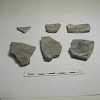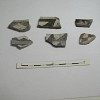
| Culture | Branch | Tradition | Ware | Type |
| Ancestral Pueblo: Greater Upper Rio Grande Valley | Northern Rio Grande | Taos (Northern Tiwa) | Taos White Ware | Taos Black-on-white |
Type Name: Taos Black-on-white |
|
| Period: | 1050 A.D. - 1350 A.D. |
| Culture: | Ancestral Pueblo: Greater Upper Rio Grande Valley |
| Branch: | Northern Rio Grande |
| Tradition: | Taos (Northern Tiwa) |
| Ware: | Taos White Ware |
First posted by C. Dean Wilson 2014
Taos Black-on-white was defined by Mera (1935). This type represents the earliest white ware manufactured in the Taos Valley. Taos Black-on-white is decorated with mineral paint and with decorative styles similar to those employed throughout much of the Northern Southwest during the Late Pueblo II period and Early Pueblo III periods (Levine 1994; Mera 1935; Peckham and Reed 1963; Wetherington 1968). This type appears to have been first produced around A.D. 1050 and continued until A.D. 1350 long after Kwahe’e Black-on-white was no longer produced in areas to the south.
One problem commonly encountered in classifying early white wares from the northernmost regions of the concerns the distinction of Taos Black-on-white from the Taos area from Kwahe'e Black-on-white from the Tewa Basin and related localities. These types are stylistically similar, and were originally differentiated based on slip, temper, or stylistic characteristics. Criteria and definitions previously used to distinguish these types, however, were often ambiguous or contradictory. In his original descriptions of these two types Mera (1935) noted a number of stylistic similarities, but described the slip as being thicker in Taos Black-white as opposed to the thin wash described for Kwahe'e Black-on-white. Mera (1935) described the temper of Kwahe'e Black-on-white as consisting of crushed potsherd and a sandy substance. More recent examinations indicate that Kwahe'e Black-on-white actually represents self-tempered clay containing various combinations of tuff, ash, and fine sand or silt fragments. Mera described Taos Black-on-white as sometimes containing coarse rounded particles, while more recent examinations indicate the use of a self-tempered clay with slightly different combinations of volcanic and sand inclusions than noted for Kwahe'e Black-on-white.
Other studies also noted stylistic similarities between these two types, and emphasized differences in slip and temper characteristics although subsequent descriptions and definitions of both of these types differed somewhat from descriptions presented by Mera (1935). Lent (1991) attempted to resolve apparent contradictions concerning various definitions and distinctions of Taos Black-on-white and Kwahe'e Black-on-white by examining sherds from surface collections used by Mera to defined these types. These examinations indicate variability and overlap in sherds assigned to both of these sites. Based on these examinations, Lent (1991) stated that the criteria previously used to differentiate these types were unreliable. He noted that the distinction between these two types was largely not warranted. He assigned mineral painted sherds for which distinctions could not be made based on the presence or absence of exterior slip as Taos Black-on-white or Kwahe'e Black-on-white.
Data from recent studies indicate that Taos Black-on-white might be best regarded as most as a variety of Kwahe'e Black-on-white distinguished from the Tewa Basin (or Kwahe'e variety) of this type by minor differences in the inclusions found in the self-tempered clays utilized in the two different areas. Other similarities are reflected by similar forms including bowls and jars and similar hachured and solid design styles. These differences, while slight, do seem to provide the basis for the distinction of Kwahe'e Black-on-white from Taos Black-on-white varieties.
Like Kwahe'e Black-on-white, the range of painted styles on Taos Black-on-white is similar to that noted for Late II types produced in the Colorado Plateau during the late Pueblo II period. No particular motif seems to dominate this type, although hachured forms are fairly common representing about a quarter of the pottery assigned to this type. Designs are often executed in simple and broadly executed patterns that cover much of the vessel surface. These decorations may include single motifs presented in an all-over or banded layout, although rudimentary combinations of different design elements may occur. The design element most commonly associated with Kwahe'e Black-on-white and other regional types dating to this span consisted of a series of rectilinear bands filled with diagonal, squiggle, straight, or cross hachure. Other designs noted include dots, opposing triangles, radiating triangles, step triangles, checkered triangles, checkered squares, parallel lines and scrolls.
References:
Boyer, Jeffrey L. and Daniel Wolfman
1997 Dating the Valdez Phase: Chronometric Reevaluation of the Initial Anasazi Occupation of North-Central New Mexico. Archaeology Notes 164, Office of Archaeological Studies, Museum of New Mexico, Santa Fe.
Ellis, Florence H., and J. J. Brody
1964 Ceramic Stratigraphy and Tribal History at Taos Pueblo. American Antiquity 29 (3):316-327.
Lent, Stephen C.
1991 Kwahe'e Black-on-white and Taos Black-on-white: The H.P. Mera Type Sites. Pottery Southwest 18 (3).
Levine, Daisy F.
1994 Ceramic Analysis. In Studying the Taos Frontier:The Pot Creek Data Recovery Project, Vol. 2: Discussion and Interpretation, edited by J. L. Bowyer, pp. 339–366. Archaeology Notes, 68. Office of Archaeological Studies, Museum of New Mexico, Santa Fe.
Mera, H. P.
1935 Ceramic Clues to the Prehistory of North Central New Mexico. Laboratory of Anthropology Technical Series Bulletin No. 8. Santa Fe, New Mexico.
Peckham, Stewart, and Erik K. Reed
1963 Three Sites near Ranchos de Taos, New Mexico. In Highway Salvage Archaeology, Vol. 4, assembled by S. Peckham, pp. 1–28. New Mexico State Highway Department and Museum of New Mexico, Santa Fe.
Wetherington, Ronald K.
1968 Excavations at Pot Creek Pueblo. Fort Burgwin Research Center Report No. 6. Taos.
Wiseman Regge N.
2014 Introduction to Mera’s “Ceramic Clues to the Prehistory of North Central New Mexico. In Since Mera: The Original Eleven Bulletins, With Essays and Opinions Derived from Recent Research, edited by E. J Brown, R. N. Wiseman and Rory P. Gauthier, pp 197-223. Archaeological Society of New Mexico, Albuquerque.
Related Photos
 © New Mexico Office of Archaeological Studies, a division of the New Mexico Department of Cultural Affairs.
© New Mexico Office of Archaeological Studies, a division of the New Mexico Department of Cultural Affairs.
The Center for New Mexico Archaeology
7 Old Cochiti Road
Santa Fe, NM 87507
505-476-4404
Fax: 505-476-4448














